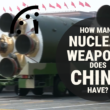Admitting when you’re scary
By Nancy Gallagher, July 9, 2015
I agree with my roundtable colleagues Wu Chunsi and Bharath Gopalaswamy on important points—possessing antisatellite weapons doesn't make it rational for any country to launch a nuclear war, and universal implementation of credible no-first-use policies would reduce nuclear risk more directly than would limiting space weapons. But I dispute my colleagues' underlying premise that when Americans warn about the dangers posed to international security by the spread of antisatellite capabilities, they are only trying—in order to preserve US military, technological, and economic dominance—to prevent potential competitors from acquiring capabilities that Washington developed decades ago.
No matter what officials in various nations say they are doing in space, the spread of antisatellite capability is real. China, with its 2007 “outer space experiment,” demonstrated it could destroy one of its own satellites with hit-to-kill technology—much as the United States showed in 2008 it could adapt an Aegis missile defense interceptor to break up one of its satellites (the USA-193, whose fuel tank putatively could have threatened “public safety”). Likewise, though India is conducting antisatellite research in the context of a ballistic missile defense program rather than through a stand-alone antisatellite development program, there is nothing militarily significant about this distinction.
The potential negative effects of antisatellite weapons on deterrence stability, crisis stability, and arms race stability have been debated for decades. Concerns about such issues were not invented to delegitimize China’s space program. Indeed, they were a central part of the arms control logic that produced the 1967 Outer Space Treaty—and also produced a tacit regime for antisatellite restraint that persists, in part, today. By the late 1950s, nuclear-tipped ballistic missiles gave both the Soviet Union and the United States a latent antisatellite capability. In the late 1960s, the Soviets experimented with a rudimentary non-nuclear antisatellite weapon. But neither Moscow nor Washington pursued a dedicated antisatellite program as quickly as it could have. Neither conducted an antisatellite attack. Both sides calculated that whatever short-term advantage might accrue from shooting down an adversary's satellite during a crisis did not outweigh the risk of conflict escalation.
To be sure, US antisatellite policy has not remained consistent over the years. The Carter administration unsuccessfully attempted to negotiate legal constraints on the development and use of antisatellite weapons. The Reagan administration—which considered the Soviet Union even less predictable, transparent, and restrained than China is considered today by the most hawkish US military and political leaders—rejected this approach. The George W. Bush administration pursued antisatellite weapons (and missile defense) at least as enthusiastically as the Reagan administration had, though its rationale was to prevent weaker countries from conducting asymmetrical attacks against the United States and its allies, not to deter massive attacks by roughly equal military powers.
Today, the US military remains number one in space by far, but it doesn’t exercise the complete offensive and defensive control called for in the US Space Command’s Vision for 2020—a level of primacy that would provide Washington free access to and use of space for its own purposes; an ability to protect all its space assets; and a capacity to deny other countries access to space for hostile purposes. Nor has the international community asked the US military to “command the commons” of space as a global public service. Other countries would in any case resist US efforts to command the commons, so fulfilling such a mission would be difficult, expensive, and risky.
Going forward, the United States, China, India, and other nations will likely develop increasingly sophisticated space capabilities, whether dual-use or strictly military, along with elaborate scenarios for how these capabilities might be used to gain or offset advantage in a crisis or low-level war. Mistrust will mount. Money will be diverted from other uses. Secrecy regarding space budgets, acquisition programs, and operations will be tightened. A wide range of security risks will grow more severe.
Strategic dialogue will only ameliorate the situation if all sides admit that some of their outer space experiments, missile defense projects, and efforts to control space as a global commons make other states feel extremely insecure. Certainly, insecurity can be reduced as it was for decades—through a mix of formal rules, informal reciprocal restraint, and reassurance. But as Wu has alluded to, insecurity will more likely be reduced if efforts to strengthen the rule-based order in space are pursued in a mutually beneficial, equitable, and inclusive way. Such efforts cannot be narrowly focused on one type of threat, such as destructive antisatellite weapons, or one type of risk, such as nuclear war.
Topics: Nuclear Weapons, Technology and Security
Share: [addthis tool="addthis_inline_share_toolbox"]














